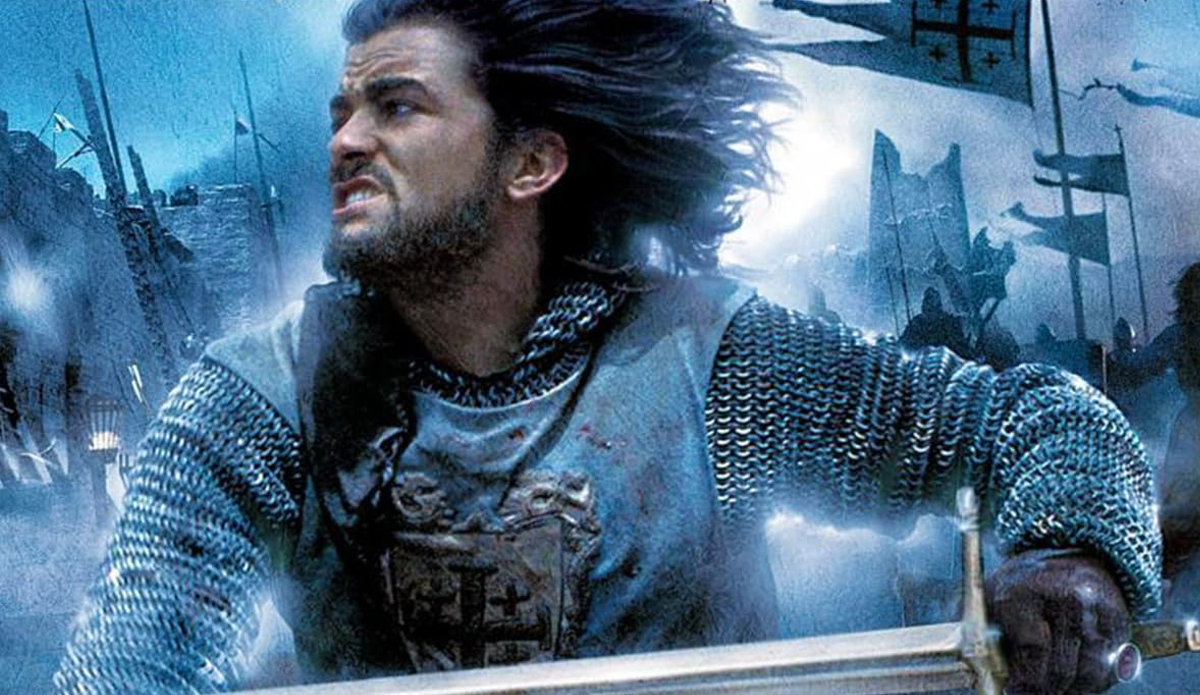
Watching the extended director’s cut DVD of Kingdom of Heaven nearly 18 years after its release (and nearly 20 in the case of the film’s original theatrical run) is a curious thing. Among Ridley Scott’s many insights into what may still be his most beautiful looking historical epic to date, the director muses on the commentary track that the home media market is something of a godsend. Because even two decades ago, the modus operandi was “faster and simpler.”
“I think the value of this digital market is people are more willing or more ready to sit at home and enjoy the longer version,” Scott reflected. “Thank God for DVD.”
That long lost home market of yore really was a gift to filmmakers, and few of them benefited from it better than Scott. The British director famously achieved a kind of absolution when he was able to re-edit Blade Runner the way he preferred: visceral, aloof, and absent of answers, be it from hackneyed voiceover narration or an even hackier tacked-on ending.
The most remarkable of Scott’s cinematic exhumations though remains Kingdom of Heaven. Released in a truncated and confounding form in May 2005, the theatrical version critics generally hated felt oddly rushed in spite of its 144-minute running time. There was no music between its notes, nor any characterization for its cast of thousands, even with Harry Gregson-Williams’ magnificent score.
But due to the DVD market Scott praised—and 20th Century Fox’s desire to get in on that Lord of the Rings double-dip phenomenon—Scott was allowed to make a version of Kingdom of Heaven that had no obligations to studio notes or commercial obligations. Running at a monumental 194 minutes, the director’s cut of the film is 50 minutes longer, and for all intents and purposes a different movie. That movie is also a far richer and more layered one. Beyond just letting scenes breathe with extended transitions or pauses between dialogue, this director’s cut reworks core characterization and world-building. Ultimately, it changes the meaning of the film entirely. Below are just three examples which illustrate the profound degree of improvement Kingdom of Heaven experiences when you let it stretch its legs.
A Renaissance Man in the Middle Ages
When Kingdom of Heaven was released, a common critique among film critics and history buffs alike was in regard to the film’s central hero. Balian d’Ibelin was a real historical figure who defended and ultimately surrendered Jerusalem to Saladin in 1187, and in a way that prevented a genocidal massacre. But as played by Orlando Bloom in the film’s theatrical cut, the man comes across as a cipher. Admittedly, Bloom’s version of Balian is not based on the historical figure beyond the film’s climactic siege, but in the theatrical cut, he seems to have almost nothing to do with reality either.
Kingdom of Heaven simply introduces Balian as a blacksmith and bastard son of a Crusader knight who has returned home in his old age. It is clear why the otherwise childless Sir Godfrey d’Ibelin (Liam Neeson) would want to claim Balian. It is unclear, however, why Balian is being driven to take his offer by a meddlesome priest (Michael Sheen) or what qualities a mere blacksmith could offer the Kingdom of Jerusalem. Nonetheless, inside of what appears to be a fortnight, the Christian king in the Holy Lands decides to entrust his realm to some dude with no military experience.
This impression of the character exasperated screenwriter William Monahan, who penned Kingdom of Heaven and infused the film with a philosophical bent, which included turning the historical Baldwin IV into a genuine philosopher king and modeling the medieval protagonist on our image of someone who might rise to prominence a few centuries later.
“He’s a sort of provincial Leonardo,” Monahan said on the same commentary while drawing comparisons to his conception of Balian with the Italian Renaissance painter and sculptor who dabbled in engineering, architecture, and proto-scientific research. Monahan similarly likens Balian to Michelangelo, who in addition to famously painting the Sistine Chapel also designed St. Peter’s Basilica in Rome. One might also draw a parallel to a contemporary of Da Vinci’s, Machiavelli, who never ruled Florence, but was a man the rulers listened to.
This is foreshadowed early in Monahan’s script, with Sheen’s priest informing Sir Godfrey and his entourage that Balian has worked as an architect on the local lord’s growing cathedral and as an engineer who designed “engines” (catapults) that fired large rocks at great distances. Unfortunately, scenes like this have only ever been available on disc.
“A little more credible for the defender of Jerusalem, no?” Monahan said about the scene in question. “Of course all that’s in the film in how it’s written and shot. He was in no way the simple blacksmith [seen in] the theatrical cut. He’s literate and, as we later see, he’s not only an experienced war veteran but a disillusioned one.”
Similarly, when Balian finally meets the mysterious King of Jerusalem, the saintly and tragic Baldwin IV (Edward Norton at his most graceful and soft-spoken while hidden by a silver mask), the young knight is not just asked about his morality; the Leper King also tests Balian’s intellect and challenges him to improve the fortifications that are already being renovated around the walls of Jerusalem.
The theatrical cut removes virtually every beat like this, depriving the character of his mind, although the heart doesn’t fare much better. In fact, simple little beats which tracked Balian’s mourning for his wife and newborn daughter were also deleted. His very first scene in the director’s cut is Balian staring at his wife in a garden planting a tree, before transitioning to his present misery in a frigid winter as a widower. This simple moment adds so much clarity to Balian’s mindset in the film, and also pays off when Balian returns home from the Crusades and finds the same tree now grown and flourishing.
Yet it was cut because, as Scott noted, “There was some confusion about who did what to who, and how did she die. I think it’s very straightforward. But somehow it kept occurring as questions. We tried to fix it in every other way, except the right way, which is simply to let it run as long as it runs right now.”
Cain and Abel Revisited
Another core element that enriches the movie with only a handful of lines and glances is the revelation that Michael Sheen’s aforementioned priest is Balian’s younger brother. Given that Balian was the bastard child of Sir Godfrey, who it is heavily implied raped the mother of both Bloom and Sheen’s characters, the disdain for his brother becomes clear—as is what the priest has to gain by sending Balian to the Holy Land.
As Balian’s younger brother, the priest would inherit both Balian’s forgery and the plot of land it rests on. While hardly a fortune, in the Middle Ages it would be quite valuable to a poor brother of Christ. This detail also heightens Balian’s need for absolution and penance; he doesn’t just murder a man in his forgery—a mortal sin—but he skewered his own brother on a sword after the priest revealed he had Balian’s deceased wife’s head removed (a grisly mutilation performed on suicides in this period).
These details are expressed through a few gestures and a few lines of exposition, but suddenly a scene that appeared rote in the theatrical cut (the hero kills a corrupt priest) takes on a biblical significance which enhances the oppressive religiosity of this tale about men willing to fight and die for different interpretations of the same God.
The Tragedy of Eva Green’s Sibylla
The element that most benefits from Kingdom of Heaven’s expansion is Eva Green’s princess-turned-queen, and the ghastly but entirely understandable sin that put her on that chair. If you have only seen the theatrical cut of Kingdom of Heaven, you might be forgiven for being unable to get a read on this character, who in the film seems in love with Bloom’s Balian and then immediately willing to consign herself to her faithless, warmongering, and dimwitted husband, Guy de Lusignan (Marton Csokas).
But that’s because she didn’t willingly get into bed with Guy after her beloved brother and king died of leprosy. In fact, she didn’t even become queen at this point in the story or history: she had a son who ruled briefly as King Baldwin V.
We know factually that Baldwin IV ruled for a scant 11 years, during which time he defeated Saladin, once, and governed Jerusalem in a state of weary detente, welcoming Christians and Muslims alike (although it might have been more out of political necessity than moral enlightenment). After he finally succumbed to his disease, his sister’s son, also named Baldwin, ruled for an even scanter two years. We do not know how the boy died, but the facts are that he was sickly and the son of Sibylla’s first husband. Ergo, there is plenty of room for dramatic license—whether that be as the child getting ill or being outright murdered by a stepfather who wants to be king.
But what Scott and Monahan lit on was a brilliantly horrifying idea: What if Baldwin V, like his beloved uncle and namesake, also contracted leprosy? What if he wasn’t killed out of avarice, but mercy? What the filmmakers came up with became the brutal heart of the movie. Earlier in the film, Balian is given the choice to weigh his soul against the needs of Jerusalem when he is offered the chance to marry Sibylla, provided he agrees to murder Guy. Sibylla chastises him for choosing his pride over the safety of Jerusalem. And yet, when she learns her baby boy will suffer the same grueling, years-long death and decay of her brother, she willingly chooses to damn the kingdom if it means euthanizing the son.
“Jerusalem is dead, Tiberias,” Sibylla cries before committing the heavy deed. “No kingdom is worth my son’s life in Hell. I will go to Hell instead.”
This sequence, as well as all of Sibylla’s nuance, contradictions, and tragedy, is excised in its totality from the theatrical cut, turning one of Green’s best performances into a ghost of a love interest.
“The trouble is the female character in a major film is always supposed to be a shoulder or an ear—some sort of tool—that unlocks the psyche of the hero and gets the hero to talk about himself,” Monahan said while reflecting on why Sibylla’s character arc was mangled in the theatrical cut. The screenwriter, after all, noted with cryptic bemusement that he had to rename Jeremy Irons’ character from Raymond (who was the real person he was based on) to Tiberias because “people in Hollywood are not careful readers,” and studio executives kept getting confused how there could be a Raymond and a Reynald in the same movie.
Scott, however, reflected on how hard it was to tell a 24-year-old Green that her work was essentially erased.
“It was the real juice of her part, and it was hard for me, [and it was] even harder for her to take,” Scott said. But some parties felt that the movie was going off on a tangent by spending time with Sibylla and her son instead of galloping into the third act where Balian would defend Jerusalem from the Saracens.
Scott disagreed. “You can argue that, but sometimes density is the best. I find density is really almost essential, rather than just the simplistic approach to anything. Our job is to entertain, and our job is to tell novels or books, stories, on film with pictures. And I would have thought density is a very good thing.”
It is, especially when you’re making an epic. The theatrical cut of Kingdom of Heaven looks like an epic: it features Scott’s painterly compositions and exquisite costumes and magnificent locations and sets. But it’s empty; the soul has been hollowed out so the action scenes occur in a back-to-back montage that signify nothing. It is the slowness of the director’s cut, the time we spend with Balian, Sybilla, and even a conniving priest, that turn this tapestry into a work of art.
The post The Kingdom of Heaven Director’s Cut Had the Most Dramatic Improvement Ever appeared first on Den of Geek.





